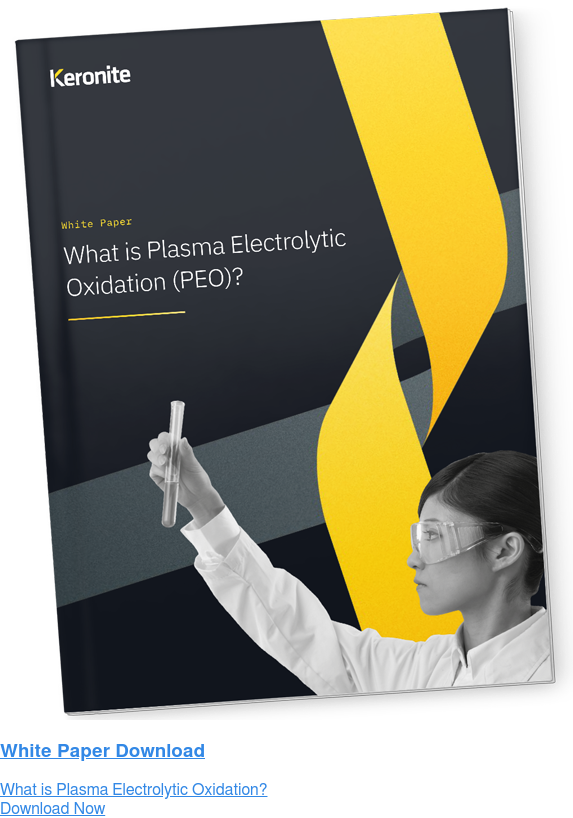Plasma Electrolytic Oxidation: The process in action
20 February 2020Light alloys are playing an important role across many sectors. This trend continues, due to radical innovations in materials science. Plasma electrolytic oxidation represents one area where vast improvements are delivering tangible benefits.
Improving light alloy performance is critical for many reasons. In automotive, reducing vehicle weight is key to reducing emissions. In space, light alloys reduce the cost of projects and fuel usage. Titanium is biocompatible, enabling its use as implants. And there is still lots of untapped potential with these materials, particularly with an artificial intelligence and robotics revolution on the cards.
Technologies like plasma electrolytic oxidation (PEO) can enhance the performance of light alloys in new and unique ways. Light alloys coated with PEO have been used in corrosive manufacturing equipment, combustion engine and even satellite applications. Each of these applications bring unique challenges, which is why PEO’s versatility unquestionably makes it one of the most advanced surface coating technologies on Earth.
To demonstrate the process, we’ve put together a video that shows exactly how the methodology works. But the coating is not just delivering coatings on materials in small-scale laboratories. The process works at an industrial scale; capable of coating parts with complex geometries at large scale.
What is plasma electrolytic oxidation?
PEO is, fundamentally, a form of conversion coating using an electrolyte bath. This invites natural comparisons with anodising, which is an alternative electrolytic oxidation technique. But while both involve submerging an alloy within an electrolyte bath, the PEO process is able to produce rock hard, porous ceramic layers that outperform anodised layers.
The PEO process involves higher voltages, complex electrical regimes and sophisticated electrolytes to create coatings that outperform alternatives. But, beneficially, the process is completely clean of toxic or hazardous chemicals.
Keronite’s ‘What is Plasma Electrolytic Oxidation?’ paper goes into more detail about the technique, with some additional information of the coatings qualities and benefits.
Video: The plasma electrolytic oxidation process in action
To illustrate the process, we’ve used a high frame rate camera and slowed the footage down (from 125,000 to 30 frames per second) to analyse the PEO process. The substrate is a circular component attached to an aluminium wire, 1mm in diameter, that we’ve illuminated.
Throughout the video, you will see the bubble surrounding each plasma discharge. The bubbles are formed by the hot discharge vaporising wear in the surrounding electrolyte. The bubble disappears as the water vapour condenses after the discharge shuts off and cools.
On the left, we’ve included a current-time plot, demonstrating the current flowing through the aluminium wire. As you should be able to see, the current spikes coincide with a bright spot – a discharge.
The current begins negative, then spikes as the applied potential switches from negative to positive. This is when the discharges begin to occur. The discharges are key to producing the ultra-hard ceramic coatings. This dismorphs the typically columnar microstructure of anodised coatings, meaning coatings are more compliant, particularly in the areas of sliding wear. It also enables ingrowth, which creates a super strong adhesion between substrate and PEO layer.
Uniquely controllable
Examining the process offers a unique insight into how PEO coatings are formed. And, with sophisticated equipment, Keronite are able to uniquely control the processing parameters of PEO. By manipulating variables such as the electrical regime, suspended particles, electrolyte composition and applied voltage, coatings can be created with very specific properties for their exact applications.
Keronite are the world leaders in plasma electrolytic oxidation technology. Following years of research and thousands of customer applications, Keronite’s scientists can create coatings that push the boundaries of possibility; enabling light alloys to be used in a whole number of intensive applications.
High performance surface coatings for tough environments
Keronite’s materials scientists have worked relentlessly on refining the process. PEO can be used for applications requiring any of the following characteristics. Furthermore, the coating is designed for high-volume manufacturing – even for intricate components with complex geometries.
- Corrosion resistance
- Thermal transmission
- Thermal barrier
- Hardness
- Dielectric breakdown performance
- Strain tolerance (compliance)
- Coating thickness
- Absorptivity
- Reflectivity
- Friction coefficient
- Electrical insulation
- Porosity
- Adhesion strength
Want to learn more?
Keronite are the world leaders in plasma electrolytic oxidation technology. With a team of in-house materials scientists and engineers, Keronite is able to combine world-class materials science research with ready-to-scale processing equipment.
To learn more about how Keronite’s technology could be used to enhance the performance of materials within your market, get in touch with our technical team. Otherwise, we have a host of other resources available to read right here.
 Keronite is now part of the CWST engineered coatings business.
Keronite is now part of the CWST engineered coatings business.
